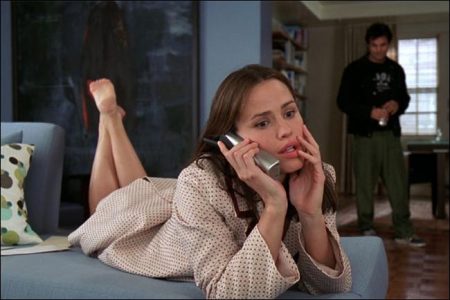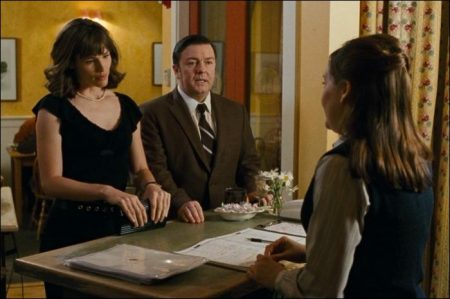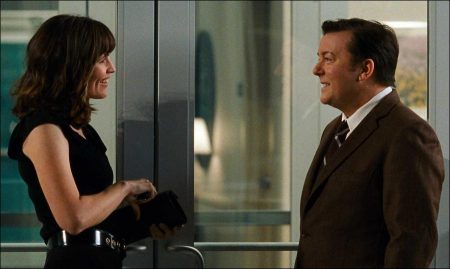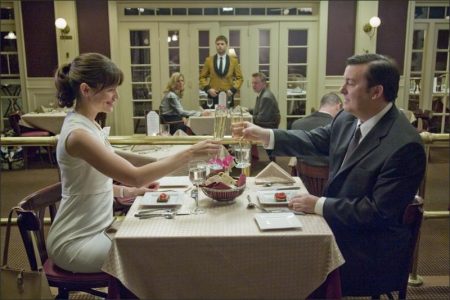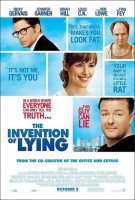All About The Invention of Lying
The Invention of Lying Movie Trailer. Lynda Obst offers, “Jen is an amazing comedienne, her timing and her deadpan performance as Anna just light up the screen. It’s a critical part because Anna is the person through whom we first discover the unconscious way they speak in this world. And her entrance in this movie is, I think, one of the most hilarious scenes in the film.”
“I blushed when I read the first scene I have,” remembers Garner. “It was the first scene I shot and, well…it went in directions I’d never gone on film before.”
Blushing aside, Garner found her character to be very optimistic, and with good reason. “She’s a little higher up on the genetic scale, which is what’s important in this world, and she makes plenty of money as a function of that. Anna sees her next step in life as finding her genetic match and having children. Unfortunately, even if she really liked Mark, she can’t have children with him because he isn’t her physical equal. It’s sort of an unwritten rule.”
But not an unspoken one; Mark is well aware of his shortcomings in that area, as is everyone else. “Mark turns out to be the first person to tell a lie,” continues Garner, “and because no one’s ever heard a lie before, they believe anything he says. He becomes very powerful and tries to use that to win Anna’s heart.” Surprisingly, though, despite becoming her equal and more in material ways, Mark’s wealth and power can’t turn this frog into a prince in Anna’s eyes, at least outwardly.
Anna only agrees to go out with Mark initially as a favor to her cousin Greg. Comedian Louis C.K. plays the part. “Greg is kind of living moment-by-moment. He has no ambition. He thinks about what he’s going to eat next, he likes drinking because it makes him feel drunk. He’ll just take whatever comes,” offers C.K. “Greg’s the guy who never had the thought that things could be better.”
“Greg is, in every sense, one notch worse off than Mark,” says Robinson. Unlike C.K., whose work has long been a favorite of both Robinson and Gervais. “Ricky and I are both huge fans of Louis’ standup, and we wanted to figure out a way to hang out with him all the time.” Putting C.K. in the movie was an easy solution for the co-directors, whose next challenge, Robinson teases, “was to figure out which role meant he’d be on set at least 75 percent of the time. Outside of that, he was also beyond perfect for Greg.”
“Amongst everything else–the concept, the romance–it’s a buddy movie,” notes Gervais. “Greg is Mark’s best friend. His only friend, really, even though he’s sort of bad for Mark. But Greg’s loyal, and loyalty is better than anything. We’re a little bit like Stan and Ollie. Steal from the best.”
Less committed to their friendship–or life itself–is Mark’s depressive neighbor, Frank, who’d like to kill himself but doesn’t quite have the moxie. “Frank is always on the verge of suicide, and Mark is bascially trying to convince him not to kill himself,” relates Jonah Hill, who portrays Frank. Hill found the character to be “a lot darker than I’ve ever played. I was happy to do a little more dramatic stuff.”
Before he was one of Hollywood’s busiest young comedy actors, Hill worked as an intern for Matt Robinson. “Jonah is one of the funniest people ever,” states Robinson. “He’s even funnier off screen than he is on screen, which is probably hard to imagine since he does such great work in his films.”
Hill has also been a longtime fan of Gervais’ work. “I loved the script Ricky and Matt wrote. I was flattered they asked me to be a part of it.”
In addition to improving his own life and the lives of his friends, Mark’s greatest impetus for telling a lie is to comfort his dying mother. Actress Fionnula Flanagan plays the role of the long-suffering Martha.
“In casting Martha, we decided not to go the comedic route and to just find a truly great actress who could be real and honest,” says Robinson. “Fionnula is one of the most talented actresses around.”
Flanagan reveals that Martha is frightened of dying. “She thinks this is the end, that it’ll just be nothingness for all eternity. Mark can’t stand to see her so scared, so he begins to tell her that it won’t be. He tells her that death isn’t really the end, and that after she dies, it will be wonderful.”
“At the end of the day, the only lie that makes Mark feel happy, beyond a momentary thrill, is easing his mother’s pain. And then that has such untoward consequences,” alludes Lynda Obst.
“Martha totally believes him because in this society,” explains Flanagan, “nobody lies and people just speak their minds all the time, whatever comes into their heads. But Mark does what nobody ever has ever done before: he makes up a story.”
In addition to being unlucky in life and in love, Mark is unlucky at work as well. Gervais notes, “Mark writes for a film company, but in this world films are simply people reading historical facts or scientific facts on camera. Titles like ‘The Invention of the Fork,’ things like that. Mark is lumbered with the 14th century, and no one wants to see that. It’s depressing. It’s just the Black Plague. Then he gets fired. But when he discovers he can lie…he can tell the greatest stories ever told.”
Actor Jeffrey Tambor plays Mark’s boss, Anthony, who attempts to fire him daily. “Anthony’s the head of the film division, but he’s in over his head,” says Tambor. “And he admits it, of course. He’s not good at confrontation, so even though he tells the others he’s going to fire Mark every day, he tries to put it off whenever he comes face-to-face with the task.”
“Funniest woman alive,” declares Robinson of Fey. “Shelly is somewhat mean-spirited, and one of the ‘better class’ of people in our world. She’s just starting out at Lecture Films, but you know that one day she’ll be an executive and probably running that place, so she’s one of the people that keeps Ricky in his loser place.”
Shelley isn’t the only roadblock Mark has to deal with at the office. His rival, both professionally and personally, is the ideal physical specimen, Brad Kessler, played by Rob Lowe.
“Brad is the top dog,” says Lowe. “He’s the best writer, he’s the Alpha male. After Mark has been fired, Brad goes to him to say how badly he feels and that he just wanted Mark to know, before he left, that Brad also hates him. Because everybody tells the truth, unprompted. Brad is really Mark’s nemesis throughout the movie, especially when it comes to Anna.”
“Rob’s character, Brad, is Mark’s enemy, though he doesn’t know that he’s an enemy because everyone’s just honest,” explains Robinson. “They are what they are. Brad’s not a villain because he’s a jerk; he has every right to be a jerk because he’s better looking, has more money, is smarter and is a better writer than Mark…and gets the prettier girls. He’s not to blame; he just happens to be Brad Kessler, and who wouldn’t want to be Brad Kessler? Brad inhabits who he is just as Mark inhabits who he is–a loser.”
“Anna and Brad look so gorgeous together that from a genetic point of view it’s truly intimidating to Mark,” affirms Lynda Obst. “That he has to win Anna away from Brad Kessler is truly overwhelming.”
“Rob Lowe is a great dramatic actor,” says Oly Obst, “but he’s also one of the funniest actors around.”
To round out the cast, Gervais and Robinson sprinkled in a few Ricky Gervais regulars, including “The Office” and “Extras” co-creator Stephen Merchant and “Extras” co-star Shaun Williamson, who both appear in a flashback from Mark’s childhood.
“I’m just here because I’m cheap, I live locally and I like to think I’m a reliable pair of hands,” jokes Merchant, who joined Williamson for the only part of the shoot to take place in England.
Williamson chimes in, “I play the part of Richard Bellison, Mark’s dad, 30 years before. I was cast because Ricky thinks I bear an uncanny resemblance to him.”
Both Brits are familiar with Gervais’ work ethic. “Ricky’s method of working is always the same,” observes Merchant. “Which is to do it as quickly as possible so he can get home and into his pajamas.”
There are also a variety of cameos from various stars, including Jason Bateman in the role of the doctor who casually informs Mark of the gravity of his mother’s illness before rushing off to dinner. Notes Bateman, “I’m the doctor who has to tell Mark that his mother is about to die. But in a world without feeling or tact, I do it quickly so I can get to the cafeteria before I miss fajita night.”
“Working with this cast was such a pleasure,” says Gervais. “I still can’t believe my luck. I can’t believe these people want to work with me. Truth is, I’m a bit of a chancer. I’m very lucky to be in this position and no one’s found me out yet.”
“What we did was make a list of the funniest people we could ever imagine working with, who we have the most respect for in the world, and that’s our cast,” adds Oly Obst.
Robinson concurs. “I’m just a really big comedy nerd. My greatest joy was just laughing all day and getting to hang out with the funniest people in the world.”
For the cast, being directed by both Gervais and Robinson–both making their feature film directing debuts–was a great experience. “They’re very smart,” notes Jonah Hill, “and they had a solid vision of the movie, so the work got done twice as fast.”
“Ricky was on set directing the actors and Matt was at the monitor so Ricky had somebody to watch his performance,” adds Lynda Obst. “And then during editing they had ways of bouncing ideas back and forth, working as each other’s sounding boards.”
Producer Dan Lin states, “I wanted to work with Ricky and Matt because they are among the most original voices in comedy today.”
“This experience would definitely make me want to work with two directors again,” says Garner. “I think it makes a lot of sense. Directors have to answer a hundred thousand questions and these guys have each other to bounce things off of, and they definitely work as one mind.”
“The most important thing I think about collaboration is the more you see eye to eye fundamentally, the fewer clashes and compromises there are,” states Gervais.
Adds Robinson, “We had a rule from the beginning that only two ‘yeses’ count, and one ‘no’ is two ‘nos.'”
“There’s none of this tit-for-tat, ‘I’ll put that joke in if you put this joke in,'” confirms Gervais. “We discussed the shots; we were fans of the same things. The groundwork was done.”
— And so I left this building and I just started walking. And I walked all the way out of town. And then I walked into the desert and I fell asleep under a tree.
After weeks of research and location scouting, the filmmakers felt Lowell, Massachusetts, located 25 miles north of Boston, would provide the quintessential, middle-America site for the lion’s share of filming “The Invention of Lying.” In addition to Lowell having perfect practical locations right in the city, the surrounding communities of Andover, North Andover, Haverhill, Sudbury, Tewksbury and Quincy met the rest of their location needs. For stage work, the production utilized a vacant warehouse, also located in Lowell. Only one scene, filmed later in England, was shot outside of Massachusetts.
Gervais asserts, “We wanted small-town America, but we wanted to create our own iconography. Lowell was great because there’s industry and these huge buildings and then there’s quaint Americana, little tree-lined streets. And it looks beautiful on film, like this idyllic place.”
Production designer Alexander Hammond notes, “Lowell is a pretty straightforward place, and it set up very nicely for us because it looks very much the way you would design a backlot town.”
“I ended up just loving Lowell,” claims Lynda Obst. “When the cold lifted at the end of May, two weeks before we finished shooting, we got to experience one of the most glorious springs I’ve ever seen. The town really gave us a beautiful look for the film, and the people were so welcoming in Lowell. I’d go back.”
Matt Robinson affirms, “We wanted a place that had a bit of a Norman Rockwell, 1950s innocence, a ‘simpler times’ kind of feel to it. All the boxes were checked off in Lowell.”
Other ideas regarding the look and feel of the town were addressed by the filmmakers. Hammond details, “Because the basic story is a very human story, we wanted to keep the world realistic, naturalistic, mostly creating a specific look for it through elimination.
“We also had a lot of conversations about how you re-envision technology in a world where there isn’t really a big push for innovation,” says Hammond. “There aren’t five hundred thousand different kinds of phones. There’s a phone. There’s a cell phone, maybe two. Televisions look like they’re from the 1980s–there aren’t flat screens. But at the same time, it’s not a period movie. They have computers, they have e-mail, they have automobiles, airplanes–everything that we have in our world, just fewer versions of them. There are three different colors of cars: white, black and silver. Basically it’s a monochromatic palette.”
Where the designers had a good deal of fun was in creating the town’s signage. Hammond recalls, “Boy, did we tone ourselves down on that, because the signage is wonderful when they really have to tell the truth. The whole idea of advertising is very different.” For example, when Mark goes to a casino, “They announce exactly what the true odds are,” laughs Hammond. “If you’re playing craps, there’s a 75 percent chance you’re going to lose. Everybody’s very up-front about that.” And the bar that Mark and Greg frequent? Hammond remarks, “‘Cheap Place to Drink.’ And a motel would be advertised as ‘A Cheap Motel for Intercourse with the Nearest Stranger.'”
— Well you already know a lot about me. You know I’m good-looking because… well… here I am. You know I’m successful because you’ve seen my apartment and the clothes I’m wearing. And you know I’m happy because I’m smiling.
For costume designer Susie DeSanto, the challenge on “The Invention of Lying” was to make the costumes stylish and attractive within the confines of the movie’s world. “There’s no fashion,” DeSanto notes. “Everything had a simple, less-adorned, less-fussy look to it. But it still had to look contemporary.”
As with the location, DeSanto found herself going back to a simpler time, a 1950s silhouette, a “de-sentimentalized Norman Rockwell palette,” she says. “The only patterns were classics–tweeds, herringbones, plaids and simple stripes. Clean lines. Everybody has a waist, men tuck their shirts in.”
Gervais and DeSanto had a very specific look in mind for the character of Mark. “Jack Lemmon in ‘The Apartment’ was the biggest influence on Mark’s look,” offers Gervais, “with a bit of the British actor Tony Hancock.”
“For Ricky’s character, we started out with his sort of schlumpy brown suit,” says DeSanto. “Then, as he becomes more successful, he gets his charcoal gray power suit. And later, when it all goes to his head, he starts wearing all black and black leather. Ricky dubbed it ‘his `80s rock star look.'”
For Garner’s Anna, DeSanto looked to fashion icons Audrey Hepburn and Grace Kelly. “They both had a classic, simple, enduring style,” says DeSanto, who has worked with Garner before on the film “13 Going on 30.” The two women enjoyed the reunion.
“Susie’s my favorite,” exclaims Garner. “I loved the clothes for Anna–gorgeous in their cut and their simplicity. Timeless.”
“Jen wears clothes beautifully,” says DeSanto. “It was a real treat to work with her again because she’s a doll and fun to dress. We had a great time together.”
Rob Lowe’s Brad also fared well in the costume department. “We based Brad on Cary Grant,” the designer reveals. “Rob wears clothes well. He knows them and likes them, and I think he had fun with it.” The character’s one imperfection is a pair of “Clark Kent” glasses. “It’s kind of ridiculous how handsome he is so I think the glasses were an excellent choice for him; they helped him take it to another level and really bring out Brad Kessler.”
At the opposite end of the fashion spectrum was Louis C.K.’s character, Greg. “Dirty tank top, a light-colored, filthy hooded sweatshirt, sweatpants and a pair of `80s tennis shoes,” smiles DeSanto. “That was basically Greg’s uniform throughout the movie. Oddly, though, I grew to love it. It photographed wonderfully.”
— Today I stumbled upon something no man has ever stumbled upon before. What I have done today they will write about in history books for generations to come. I said something… that wasn’t.
What is the absolute truth is that the cast and crew of “The Invention of Lying” had an honest-to-goodness good time working together. Nerf Wars. “Corpsing.” And that laugh. Oh, that laugh.
“It started with one gun we had in the office and within the first minute, like two six-year-old kids, Ricky walks in and we’re both like, ‘All right, let’s go,'” confesses co-writer, co-director–and co-conspirator–Matt Robinson.
“I wince every time I see a Nerf gun now,” shudders producer Dan Lin with a smile. “I was usually the victim of a blaster, and they usually ambushed me when I was in the middle of a conversation.”
“Ricky started the Nerf gun thing. But of course, there was no way I was coming in and not playing,” producer Oly Obst defends.
Gervais had one rule: “They couldn’t shoot me. I’m on screen. Simple rule. Then on the last take of the last day, they waited. They waited for seven weeks and on my last take, I came out the door and it was like ‘Butch Cassidy and the Sundance Kid.'”
One could say that revenge was not only sweet, but well-deserved payback for Gervais’ uncontrollable “corpsing,” a term the Brits use for breaking up in the middle of a take.
“Ricky has the concentration of a horsefly,” laughs Oly Obst. “He will laugh in the middle of a take and then say, ‘Okay, I’m ready.’ And they go again, but of course he isn’t ready. He just busts up again.”
According to the film’s cast and crew, it’s not just the fact that Gervais laughs inappropriately on set–his laugh itself is equally distracting.
“Constant and in my ear. And usually at my expense,” concedes Robinson.
“I’m going to hear the Ricky cackle in my sleep,” Rob Lowe teases. “But that’s cool, because as an actor you know you’re doing well when you hear the Ricky cackle.”
Oly Obst elaborates, “Ricky’s laugh is gigantic. And it’s contagious. And, yes, it’s like a little girl’s sissy laugh. I love it.”
Of the experience overall, Robinson says, “Just to hang out with so many of my idols, and to get to know Ricky and to work with him and make what we hope will be a really special movie that we can be proud of… that was the best part of all.”
Star Jennifer Garner believes the movie “has all the elements of a traditional, feel-good, make-you-laugh, make-you-cry romantic comedy. But it does all that from just a slightly different perspective.”
“It’s an improbable love story, it’s not a traditional comedy,” states Oly Obst. “You have to come at it from the side and hope to catch something really special.”
Producer Lynda Obst agrees. “There are some really original ideas packed into this movie, including some about love and why you should pick one person over another, and that you can make your own choices and that each choice is equally valid.”
“Not only do I think this is a laugh-out-loud comedy, but I believe the film makes you think and ask provocative questions afterward,” remarks Lin. “It resonates in a way that prompts discussion–what would the world really be like if everyone always told the truth?”
“Everything we do should be a comment on the world. Everything,” says filmmaker and star Ricky Gervais. “I think this movie is a funny way to make people reconsider their first impressions of others, and how we might feel if we really knew what people were thinking about us.”
Production notes provided by Warner Bros. Pictures
The Invention of Lying (2009)
Directed by: Ricky Gervais
Starring by: Ricky Gervais, Jennifer Garner, Rob Lowe, Jonah Hill, John Hodgman, Tina Fey, Jeffrey Tambor, Nate Corddry, Patrick Stewart, Jason Bateman, Fionnula Flanagan, Stephanie March
Screenplay by: Matt Robinson
Production Design by: Alec Hammond
Cinematography by: Tim Suhrstedt
Film Editing by: Chris Gill
Costume Design by: Susie DeSanto
Set Decoration by: Kathleen Rosen
Art Direction by: Priscilla Elliott
Music by: Tim Atack
MPAA Rating: PG-13 for language including some sexual material and a drug reference.
Distributed by: Warner Bros. Pictures
Release Date: October 2, 2009
Views: 162
